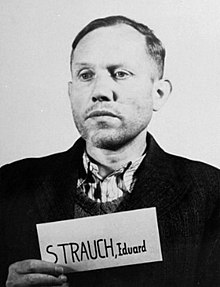Eduard Strauch
Eduard Strauch (17 August 1906 – 15 September 1955) was an SS-Obersturmbannführer, commander of Einsatzkommando 2, commander of two Nazi organizations, the Security Police (German: Sicherheitspolizei), or Sipo, and the Security Service (German: Sicherheitsdienst, or SD), first in Belarus – then called White Russia or White Ruthenia – and later in Belgium. In October 1944, he was transferred to the military branch of the SS (Waffen-SS).
Eduard Strauch | |
|---|---|
 Mug shot Eduard Strauch for war crimes trial | |
| Born | 17 August 1906 |
| Died | September 15, 1955 (aged 49) |
| Occupation | Nazi police official |
| Motive | Nazism |
| Conviction(s) | Crimes against humanity in Latvia, Belarus, and Belgium |
| Criminal penalty | Death by hanging (never carried out) |
Life
Born in Essen, Strauch first studied theology at the universities of Erlangen (now Erlangen-Nuremberg) and Münster, but changed his course of studies and graduated with a degree in jurisprudence. On 1 August 1931 he joined the Nazi Party (membership no. 623.392) and SA. On December 1, 1931 he became a member of the Nazi SS organization (membership no. 19.312). As of December 1934 he began working for the SD.
Crimes against humanity
Like many other employees of the SD, at the beginning of the German invasion of the Soviet Union, Strauch assumed command of a unit of the Einsatzgruppen. Strauch led Einsatzkommando 2, which was part of Einsatzgruppe A, which beginning on November 4, 1941 was under the command of Franz Walter Stahlecker. On November 30, 1941, he participated, with 20 men under his command, in the murder of 10,600 Jews of Riga in the Rumbula forest near the city.[1] As a reward for this "service" he was promoted to commander in Sipo and the SD and transferred to Belarus. In July 1943, the Nazi general commissioner for White Russia reported on having had a conference with the "extremely capable [...] chief of the SD, SS-Obersturmbannführer Dr. jur. Strauch “, who had caused "the liquidation of 55,000 Jews in just the past 10 weeks alone." Strauch had difficulties within the SS. SS-Obergruppenführer Erich von dem Bach-Zelewski, himself a perpetrator of the genocide, described Strauch as "the worst human I ever met in my life". Strauch's promotion to Standartenführer was denied. On 31 May 1944 he was appointed Sipo and SD commander in Belgium. In October 1944 Strauch was transferred to the SS military branch the Waffen-SS.
After 1945
Despite an effort to sham mental illness, Strauch was convicted by the Nuremberg Military Tribunal in the Einsatzgruppen trial for having a key role in the Rumbula and a number of other mass murders in Eastern Europe. On April 9, 1948, Presiding judge Michael Musmanno pronounced the tribunal's sentence on Strauch:
Defendant EDUARD STRAUCH, on the counts of the indictment on which you have been convicted, the Tribunal sentences you to death by hanging.[2]
Unlike his co-defendants Otto Ohlendorf and Paul Blobel, Strauch did not hang. Instead, he was handed over to authorities in Belgium, where he had committed other crimes, for trial. He was again convicted and sentenced to death, but this sentence likewise was never carried out. Strauch died in Belgian custody on September 15, 1955 in a hospital in Uccle, Belgium.[3]
Notes
- Einsatzgruppen judgment, at 563-567
- Einsatzgruppen judgment, at 589
- (in Italian)Eduard Strauch, biography and photo at Olokaustos.org Archived 2002-02-11 at the Wayback Machine
References
External links
| Wikimedia Commons has media related to The Holocaust in Latvia. |